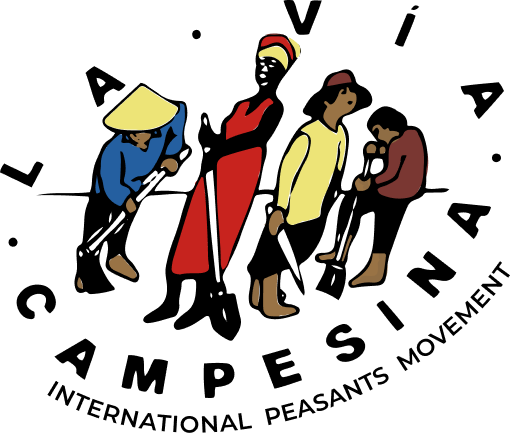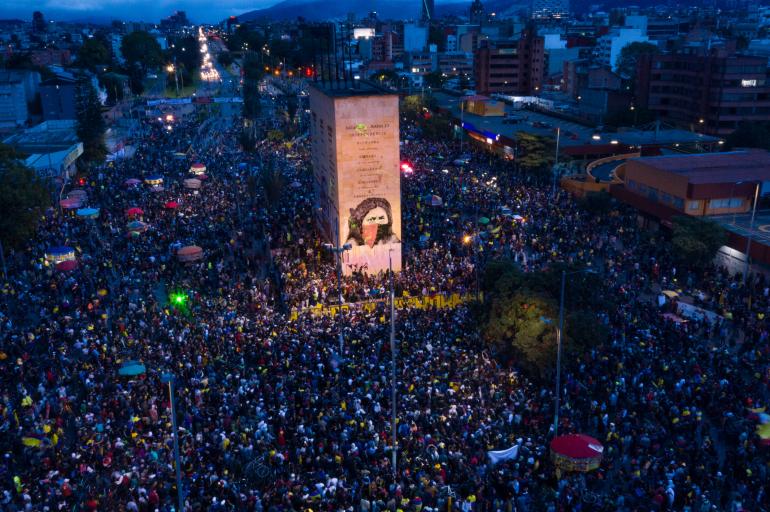Protests unleashed by President Duque’s tributary reform have turned into a nationwide protest for historic injustices and the deepening economic crisis behind the pandemic. The Colombian people, who have been protesting since April 28, are now facing state terrorism.
The tributary reform project tabled by President Duque on April 5, 2021 – having the vision of the International Monetary Fund (IMF) – aimed to collect 23 trillion pesos by increasing taxes on the household basket and labor income of the medium class, at the same time, the tax benefits for big companies, costing 94 trillion pesos1, annually are maintained.
In Colombia, exemptions and tax reductions for large companies have been increasing during the last 3 years, the most aided sector being the financial sector, then trade, mining, and petroleum. Under this logic of the present neoliberal government, big companies are those receiving allowances to face the crisis generated by the pandemic, meanwhile, the hungry Colombians hoisted red flags at home, begging for help.
The crisis generated by COVID-19 caused that a quarter of Colombian households went from eating 3 times a day to only 2, this in a context where the poverty index stood at 42.7% and the situation of misery at 15.1%. It should be noted that, according to the National Administrative Department of Statistics, a Colombian household suffers from monetary poverty when the income of a person is lower than 331 688 pesos (USD 90) and extreme poverty or misery when the income is lower to 145,000 pesos (USD 39.3)2.
The social outburst unleashed by the tributary reform is also a product of the security crisis, the upsurge in violence and the government’s failure to respect the Peace Agreement. Currently, the increase in levels of violence is equivalent to the records of the decade 1995-2015, the most violent of the armed conflict. The increase in the territorial presence of various illegal armed groups, mainly paramilitaries, increases the phenomena of violence and terror aimed at obtaining territorial control. In 2020 alone, 91 massacres causing 381 victims were recorded, and in the first 4 months of 2021 35 incidents of this type causing 132 victims have already been recorded.
There are already 1,172 social leaders assassinated since the signing of the Peace Agreement3. Only in 2020 the assassination of 310 social leaders was recorded, and 62 victims were recorded between January 1 and May 9, 2021. Most of the murdered are leaders of peasant communities, indigenous and Afro-descendant being confronted by armed groups in the service of economic and political interests; drug traffickers, land and natural resources grabbers included.
The irrepressible lack of conformity of the Colombian population in the face of the political, economic, and social reality of the country has triggered mass protests that have been taking place since April 28. The extent of the days of strike currently experienced in Colombia has not been seen since the Great National Strike of 1977. In the first 19 days of mobilizations 7,532 activities in 784 of the 1,120 municipalities of the country were recorded: 1,557 demonstrations, 3,559 mergers, 1,744 blockades and 387 mobilizations (movement of people in vehicles)4.
The demands of the mobilized people were not heeded by the government. Duque refuses to dialogue, dilated negotiations and resorted to militarization and repression to silence the population’s non-conformity: 43 demonstrators were murdered by members of the police force, 33 victims of eye attacks, 1,139 were arbitrarily arrested, 18 victims of sexual violence, more than 500 missing5 and 384 victims of physical violence.
Likewise, other violent practices have been reported, such as the use of tear gas in residential areas, the improper use of the Venom projectile launcher or the launching of tear gas from helicopters6. There have been cases of police coming out dressed in civilian clothes or without the necessary identification to threaten with firearms and capture protesters.
One of the most reproachful facts was the attack of armed civilians in the company of police officers against the indigenous minga [mutual aid organization]. On May 9, 4 chivas [traditional intermunicipal coaches] and 2 SUVs belonging to the minga left Santander de Quilichao towards Cali. One of the SUVs, where an indigenous adviser was traveling, was pulled over by residents of an upscale neighborhood in Cali. When the mingueros arrived to support the adviser, they were attacked with assault rifles by civilians, who, according to video logs, were accompanied by the police7. 10 indigenous people were injured by gunfire.
Likewise, information of meetings with businesspeople and the government party has been filtered; they seek militarization or the decree of internal commotion and manipulation of the media to criminalize the protests8.
The terror unleashed by the state has not accomplished the discouragement of the Colombian people’s decision to fight. More than 20 days on strike and the victories of popular mobilization were expressed in the collapse in the congress of the health reform project, the resignation of the Minister of the Public Treasury, the Minister of Foreign Affairs, and the reallocation of part of the resources of the war for the financing of higher education to underprivileged classes and the exploration of the dialogues with the ELN. Perhaps the most important victory of the popular mobilization is the isolation of the genocide Uribe and his fascist project, now despised by the consensus of the mobilized forces.
Duque refuses to attend a meeting with the Strike Committee and announced that on Sunday, May 17, the military forces will deploy their maximum operational capacity to unblock the roads al over the national territory. This announcement was made after the Strike Committee called for national mobilization on May 19.
The neoliberalism embodied in the government declares war against the mobilized people who have gained the confidence and the option to manage the new changes; the calling of violence does not have in mind that social processes are not stopped neither by crime nor by force.
1 Semana (January 08, 2021) Las billonarias gabelas que recibirán las empresas en pleno año de reforma tributaria Available at: https://www.semana.com/economia/articulo/las-billonarias-gabelas-que-recibiran-las-empresas-en-pleno-ano-de-reforma-tributaria/202100/
2 UN Periódico (May 10, 2021) La miseria, una seria enfermedad social. Available at: https://unperiodico.unal.edu.co/pages/detail/la-miseria-una-seria-enfermedad-social/
3 Desde la firma del Acuerdo de Paz, en noviembre de 2016, al 9 de mayo de 2021. INEPAZ. For more information: http://www.indepaz.org.co/lideres/
4 Balance General Paro nacional – 2021. Ministerio de Defensa. Available at: https://twitter.com/mindefensa/status/1394272778182856714
5 W Radio (May 10, 2021) Las cifras de la ONG Temblores sobre casos de violencia policial Available at: https://www.wradio.com.co/noticias/actualidad/las-cifras-de-la-ong-temblores-sobre-casos-de-violencia-policial/20210510/nota/4133566.aspx
6 Tu Barco (May 05, 2021) Alcaldes del Valle molestos por ‘arremetida’ del Esmad, en Buga el gas sacó hasta a los niños de las casas. Available at: https://tubarco.news/tubarco-noticias-occidente/tubarco-noticias-valle/alcaldes-del-valle-molestos-por-arremetida-del-esmad-en-buga-el-gas-saco-hasta-a-los-ninos-de-las-casas/
7 Noticias Uno (May 10, 2021) 9 de mayo, peor día de anarquía en Cali civiles contra civiles con armas, palos y ataques Available at: https://www.youtube.com/watch?v=wtjXvxcRmj0&list=PLhqS9Rdwsv9hZI7_Pa5g4U3VqF5waUDyV&index=6
8 El Espectador (May 12, 2021) La “legítima defensa” y otras propuestas del uribismo y empresarios en Pereira para frentear el paro nacional. Available at: https://www.elespectador.com/colombia2020/pais/la-legitima-defensa-y-otras-propuestas-del-uribismo-y-empresarios-en-pereira-para-frentear-el-paro/

